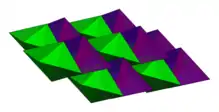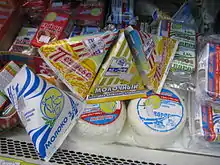In geometry, tetrahedron packing is the problem of arranging identical regular tetrahedra throughout three-dimensional space so as to fill the maximum possible fraction of space.

Currently, the best lower bound achieved on the optimal packing fraction of regular tetrahedra is 85.63%.[1] Tetrahedra do not tile space,[2] and an upper bound below 100% (namely, 1 − (2.6...)·10−25) has been reported.[3]
Historical results

Aristotle claimed that tetrahedra could fill space completely.[4] [5]
In 2006, Conway and Torquato showed that a packing fraction about 72% can be obtained by constructing a non-Bravais lattice packing of tetrahedra (with multiple particles with generally different orientations per repeating unit), and thus they showed that the best tetrahedron packing cannot be a lattice packing (with one particle per repeating unit such that each particle has a common orientation).[6] These packing constructions almost doubled the optimal Bravais-lattice-packing fraction 36.73% obtained by Hoylman.[7] In 2007 and 2010, Chaikin and coworkers experimentally showed that tetrahedron-like dice can randomly pack in a finite container up to a packing fraction between 75% and 76%.[8] In 2008, Chen was the first to propose a packing of hard, regular tetrahedra that packed more densely than spheres, demonstrating numerically a packing fraction of 77.86%.[9][10] A further improvement was made in 2009 by Torquato and Jiao, who compressed Chen's structure using a computer algorithm to a packing fraction of 78.2021%.[11]
In mid-2009 Haji-Akbari et al. showed, using MC simulations of initially random systems that at packing densities >50% an equilibrium fluid of hard tetrahedra spontaneously transforms to a dodecagonal quasicrystal, which can be compressed to 83.24%. They also reported a glassy, disordered packing at densities exceeding 78%. For a periodic approximant to a quasicrystal with an 82-tetrahedron unit cell, they obtained a packing density as high as 85.03%.[12]
In late 2009, a new, much simpler family of packings with a packing fraction of 85.47% was discovered by Kallus, Elser, and Gravel.[13] These packings were also the basis of a slightly improved packing obtained by Torquato and Jiao at the end of 2009 with a packing fraction of 85.55%,[14] and by Chen, Engel, and Glotzer in early 2010 with a packing fraction of 85.63%.[1] The Chen, Engel and Glotzer result currently stands as the densest known packing of hard, regular tetrahedra. Surprisingly, the square-triangle tiling[12] packs denser than this double lattice of triangular bipyramids when tetrahedra are slightly rounded (the Minkowski sum of a tetrahedron and a sphere), making the 82-tetrahedron crystal the largest unit cell for a densest packing of identical particles to date.[15]
Relationship to other packing problems
Because the earliest lower bound known for packings of tetrahedra was less than that of spheres, it was suggested that the regular tetrahedra might be a counterexample to Ulam's conjecture that the optimal density for packing congruent spheres is smaller than that for any other convex body. However, the more recent results have shown that this is not the case.
See also
- Packing problem
- Disphenoid tetrahedral honeycomb - an isohedral packing of irregular tetrahedra in 3-space.
- The triakis truncated tetrahedral honeycomb is cell-transitive and based on a regular tetrahedron.
References
- 1 2 Chen, Elizabeth R.; Engel, Michael; Glotzer, Sharon C. (2010). "Dense crystalline dimer packings of regular tetrahedra". Discrete & Computational Geometry. 44 (2): 253–280. arXiv:1001.0586. doi:10.1007/s00454-010-9273-0. S2CID 18523116.
- ↑ Struik, D. J. (1925). "Het probleem 'De Impletione Loci'". Nieuw Archief voor Wiskunde. 2nd ser. 15: 121–134. JFM 52.0002.04.
- ↑ Simon Gravel; Veit Elser; Yoav Kallus (2010). "Upper bound on the packing density of regular tetrahedra and octahedra". Discrete & Computational Geometry. 46 (4): 799–818. arXiv:1008.2830. doi:10.1007/s00454-010-9304-x. S2CID 18908213.
- ↑ Jeffrey Lagarias and Chuanming Zong (2012-12-04). "Mysteries in Packing Regular Tetrahedra" (PDF).
- ↑ News Release (2014-12-03). "Jeffrey Lagarias and Chuanming Zong to receive 2015 Conant Prize".
- ↑ Conway, J. H. (2006). "Packing, tiling, and covering with tetrahedra". Proceedings of the National Academy of Sciences. 103 (28): 10612–10617. Bibcode:2006PNAS..10310612C. doi:10.1073/pnas.0601389103. PMC 1502280. PMID 16818891.
- ↑ Hoylman, Douglas J. (1970). "The densest lattice packing of tetrahedra". Bulletin of the American Mathematical Society. 76: 135–138. doi:10.1090/S0002-9904-1970-12400-4. hdl:10150/288016.
- ↑ Jaoshvili, Alexander; Esakia, Andria; Porrati, Massimo; Chaikin, Paul M. (2010). "Experiments on the Random Packing of Tetrahedral Dice". Physical Review Letters. 104 (18): 185501. Bibcode:2010PhRvL.104r5501J. doi:10.1103/PhysRevLett.104.185501. hdl:10919/24495. PMID 20482187.
- ↑ Chen, Elizabeth R. (2008). "A Dense Packing of Regular Tetrahedra". Discrete & Computational Geometry. 40 (2): 214–240. arXiv:0908.1884. doi:10.1007/s00454-008-9101-y. S2CID 32166668.
- ↑ Cohn, Henry (2009). "Mathematical physics: A tight squeeze". Nature. 460 (7257): 801–802. Bibcode:2009Natur.460..801C. doi:10.1038/460801a. PMID 19675632. S2CID 5157975.
- ↑ Torquato, S.; Jiao, Y. (2009). "Dense packings of the Platonic and Archimedean solids". Nature. 460 (7257): 876–879. arXiv:0908.4107. Bibcode:2009Natur.460..876T. doi:10.1038/nature08239. PMID 19675649. S2CID 52819935.
- 1 2 Haji-Akbari, Amir; Engel, Michael; Keys, Aaron S.; Zheng, Xiaoyu; Petschek, Rolfe G.; Palffy-Muhoray, Peter; Glotzer, Sharon C. (2009). "Disordered, quasicrystalline and crystalline phases of densely packed tetrahedra". Nature. 462 (7274): 773–777. arXiv:1012.5138. Bibcode:2009Natur.462..773H. doi:10.1038/nature08641. PMID 20010683. S2CID 4412674.
- ↑ Kallus, Yoav; Elser, Veit; Gravel, Simon (2010). "Dense Periodic Packings of Tetrahedra with Small Repeating Units". Discrete & Computational Geometry. 44 (2): 245–252. arXiv:0910.5226. doi:10.1007/s00454-010-9254-3. S2CID 13385357.
- ↑ Torquato, S.; Jiao, Y. (2009). "Analytical Constructions of a Family of Dense Tetrahedron Packings and the Role of Symmetry". arXiv:0912.4210 [cond-mat.stat-mech].
- ↑ Jin, Weiwei; Lu, Peng; Li, Shuixiang (December 2015). "Evolution of the dense packings of spherotetrahedral particles: from ideal tetrahedra to spheres". Scientific Reports. 5 (1): 15640. Bibcode:2015NatSR...515640J. doi:10.1038/srep15640. PMC 4614866. PMID 26490670.
External links
- Packing Tetrahedrons, and Closing in on a Perfect Fit, NYTimes
- Efficient shapes, The Economist
- Pyramids are the best shape for packing, New Scientist